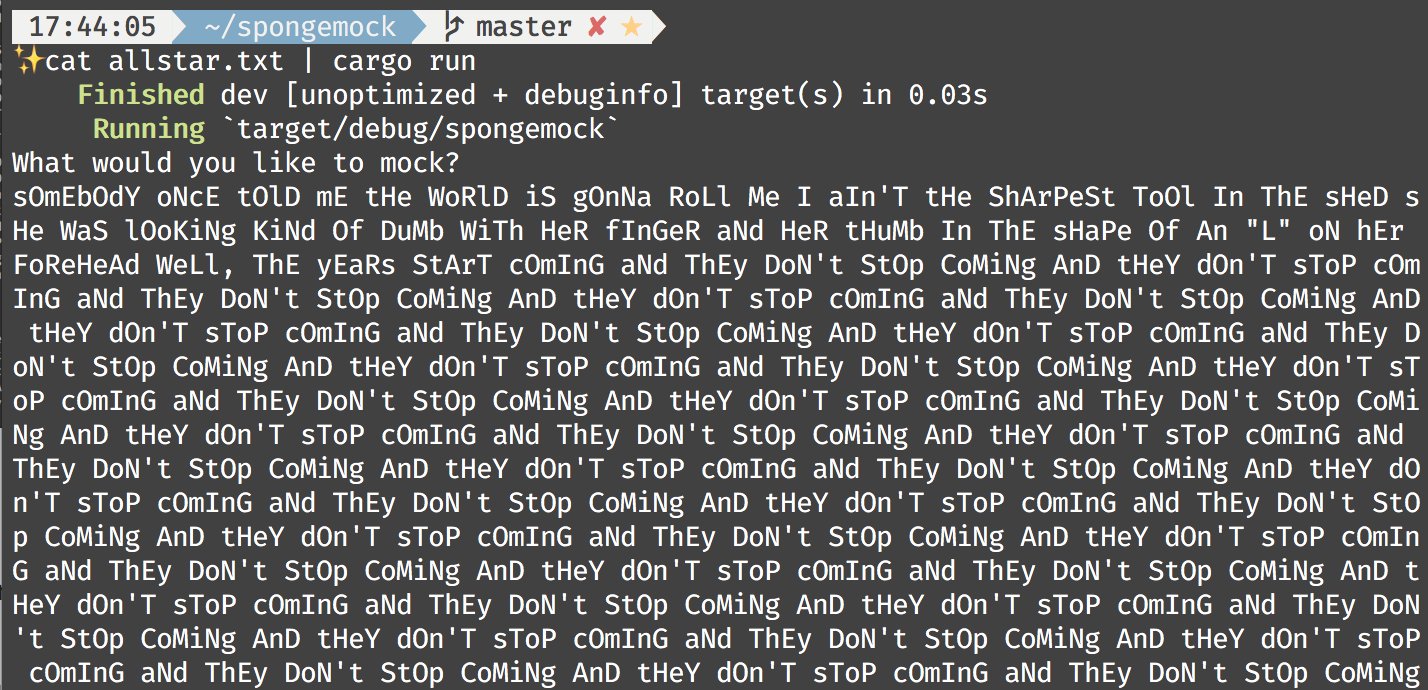🧽 In Memes We Rust
This may seem like a familiar scenario:
-
My friend says a comedically judgmental thing on Slack.
-
We all respond with an emoji representing the Mocking SpongeBob meme.
-
I try retyping their message, alternating case.
-
It’s a pain.
That was all it took to add a new item to my “learning project ideas” list: spongemock CLI. It’s simple enough to be done in one sitting but is dumb and frivolous enough where I find it fun and interesting.
Is it unique? No, of course not. Does that mean I shouldn’t do it? No, of course not!
I had been wanting to learn Rust for a while but never made it a priority. It seemed really fun! People I admire were learning it! I should learn it! So I did.
I had a week off and while I was just lounging around a house in the high desert of Oregon, sipping gin and tonics, I decided it was time to learn Rust (and work on that silly spongemock idea I had).
I found The Rust Programming Language Book (apparently called “the book” according to at least the rust lang documentation page) and immediately enjoyed how well written it was. In college, I majored in computer science and minored in psychology and the quality of textbooks was day and night: psychology books just got how people learned in a way computer science books didn’t.
The way the Rust book was formatted reminded me of those psych textbooks — it was cognizant of how people (specifically, its intended audience of engineers) learn. There’s some basic getting started but it immediately dives into a project and explains things enough as you work on it. Then it goes into details of how things work until it’s time for another project.
I decided that after the project in chapter 2, I would start working on my spongemock program and just see what I can do.
Chapter 2 gave me a really solid foundation: some input, some output, a little looping — great! I filled in the gaps I needed to complete a basic spongemock by searching for it myself. A lot of those gaps were around string and character manipulation. The way Rust handles strings and characters reminded me of C (what I mostly did in college) more than anything I’ve done in a while.
This strategy of information gathering got me pretty far! I could ask for input and mock it by alternating case for letters only, leaving alone any other character.
I mean honestly that’s the heart of spongemock. But I started dreaming up ideas! For example: making it more of a CLI than cargo run and taking command line input (it does now!) and maybe even having flags and reading from files. That’s when I started having a harder time understanding what I was finding online.
BUT GUESS WHAT: the book is so well formatted and teaches a command line program with file I/O as chapter 12.
I’ve decided that this project will be a work in progress as I go through the book. It was a good learning project because I could do it in one sitting and knock out what I needed for basic functionality. It was also a good learning project because it can grow as I learn:
-
As I learn better practices
-
As I learn file I/O
-
As I learn more about building a CLI
-
As I learn more about being a Rust programmer!
I wish my operating systems education had been less judgmental. Rust seems like a good community to relearn systems in a healthier way. I like this project because it is small, bite sized, and not serious at all. I saw a tiny itch and scratched it without worrying about if it had been built (it has) or if I was doing it right (probably not).
Best practices and unique ideas come in time and practice, they don’t have to be the priority when you start learning.
I loved getting to be a creative investigator where my only goal was a silly program for the sake of learning and I’m excited to continue down that path with the book and spongemock. I certainly will be keeping my eye out for more small joke ideas that get me excited about learning because that’s what really matters.
Want to check out my project? https://github.com/glitteringkatie/spongemock
